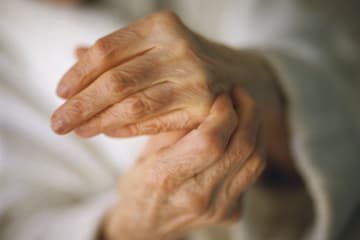
Overview
Arthritis, also called osteoarthritis, is a breakdown of the cartilage that cushions your joints. When the cartilage wears down, your bones rub against each other. This causes pain and stiffness. Many people have some arthritis as they age. Arthritis most often affects the joints of the spine, hands, hips, knees, or feet.
Arthritis never goes away completely. But medicine and home treatment can help reduce pain and help you stay active.
Follow-up care is a key part of your treatment and safety. Be sure to make and go to all appointments, and call your doctor if you are having problems. It's also a good idea to know your test results and keep a list of the medicines you take.
How can you care for yourself at home?
- Stay at a healthy weight. Being overweight puts extra strain on your joints.
- Talk to your doctor or physical therapist about exercises that will help ease joint pain.
- Stretch. You may enjoy gentle forms of yoga to help keep your joints and muscles flexible.
- Walk instead of jog. Other types of exercise that are less stressful on the joints include riding a bike, swimming, tai chi, or water exercise.
- Lift weights. Strong muscles help reduce stress on your joints. Stronger thigh muscles, for example, take some of the stress off of the knees and hips. Learn the right way to lift weights so you don't make joint pain worse.
- Take your medicines exactly as prescribed. Call your doctor if you think you are having a problem with your medicine.
- Take pain medicines exactly as directed.
- If the doctor gave you a prescription medicine for pain, take it as prescribed.
- If you are not taking a prescription pain medicine, ask your doctor if you can take an over-the-counter medicine.
- Use a cane, crutch, walker, or another device if you need help to get around. These can help rest your joints. You also can use other things to make life easier, such as a higher toilet seat and padded handles on kitchen utensils.
- Do not sit in low chairs. They can make it hard to get up.
- Put heat or cold on your sore joints as needed. Use whichever helps you most. You can also switch between hot and cold packs.
- Apply heat 2 or 3 times a day for 20 to 30 minutes—using a heating pad, hot shower, or hot pack—to relieve pain and stiffness. But don't use heat on a swollen joint.
- Put ice or a cold pack on your sore joint for 10 to 20 minutes at a time. Put a thin cloth between the ice and your skin.
When should you call for help?
Call your doctor now or seek immediate medical care if:
- You have sudden swelling, warmth, or pain in any joint.
- You have joint pain and a fever or rash.
- You have such bad pain that you cannot use a joint.
Watch closely for changes in your health, and be sure to contact your doctor if:
- You have mild joint symptoms that continue even with more than 6 weeks of care at home.
- You have stomach pain or other problems with your medicine.
Where can you learn more?
Go to http://www.healthwise.net/patientEd
Enter Z807 in the search box to learn more about "Arthritis: Care Instructions".
Current as of: July 24, 2025
Author: Ignite Healthwise, LLC Staff
Clinical Review Board
All Ignite Healthwise, LLC education is reviewed by a team that includes physicians, nurses, advanced practitioners, registered dieticians, and other healthcare professionals.

